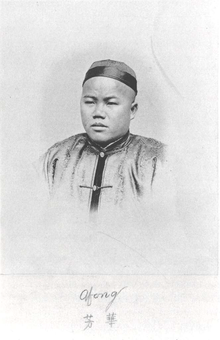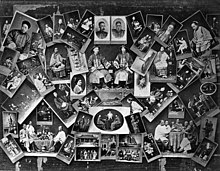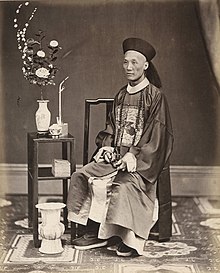Lai Afong
Lai Afong | |
|---|---|
 Lai Afong. c. 1870 | |
| Born | 1838 or 1839[1] |
| Died | (aged 51)[1] Hong Kong |
| Other names |
|
Lai Afong (Chinese: 黎芳; c. 1838 or 1839 – 1890) was a Chinese photographer who established Afong Studio, considered to be the most successful photographic studio in the late Qing dynasty.[1] He is widely acknowledged as the most significant Chinese photographer of the nineteenth century.[2][1][3]
Life and work[edit]

Lai Afong was born in Gaoming, Guangdong and arrived in Hong Kong in the 1850s as a refugee of the Taiping Rebellion.[4] It is not known how he learned the wet-plate collodion process,[5] but, it is said that by as early as 1859 had learned the art of photography.[6] At some point between 1865 and 1867, Lai Afong worked at the Hong Kong studio of Portuguese photographer José Joaquim Alves de Silveira; by 1870, the earliest known announcement of the Afong Studio was printed as an advertisement in the Hong Kong Daily Press.[1] Lai Afong's subject matters ranged from portraits and social life pictures to cityscapes and landscapes.[7] Little is known about his life, although many of his images survive today as testament to his extraordinary talent.[2] After Lai Afong's death, the business was taken over by his son in the 1890s.[8]
Lai Afong traveled through the provinces of Fujian, Guangdong, Hebei, Songjiang (today Shanghai), and Hong Kong, creating photographs. His collection of views included photographs of masterpieces of Chinese architecture such as sites within the Summer Palace and the Fragrant Hills Pagoda in Beijing, the Temple of the Six Banyan Trees in Guangzhou, and numerous others, as well as magnificent panoramas of such locations as Victoria harbor and Gulangyu island. As Lai Afong’s reputation quickly grew, both Chinese and foreign clientele flocked to his studio for portrait sessions, including some of China’s most important people such as Qing dynasty official Li Hongzhang.[9] According to the verso of many of his Carte de visite works, he was photographer to Governor of Hong Kong Sir Arthur Kennedy KCB and Grand Duke Alexei Alexandrovich of Russia.[7]

Lai Afong was the most successful of his generation of Chinese photographers in appealing to both a Chinese and foreign cosmopolitan clientele.[7] Lai Afong advertised in English-language newspapers – offering a “Larger, and more complete collection of Views than any other Establishment in the Empire of China”[10] – and the artist captioned much of his work in both Chinese and English.[11] Afong Studio photographs were sold to both Chinese patrons – both those local to Hong Kong and those visiting from other parts of China – and foreign visitors to China.[2]
The Afong Studio became a destination and training ground for foreign photographers in the region, and photographers such as Emil Rusfeldt and D.K. Griffith began their careers under the tutelage of Lai Afong.[6] In 1875, Griffith claimed that his mentor had “entered the arena of European art, associating his name with photography in its best form, and justly stands first of his countrymen in Hong Kong.”[1] John Thomson, a Scottish photographer working in China at the time, praised Lai Afong’s images as “extremely well-executed, [and] remarkable for their artistic choice of position," in his book The Straits of Malacca, Indo-China, and China.[12]
Lai Afong seems to have been the only Chinese photographer of his generation to be embraced by his foreign contemporaries.[1] However, his work is distinct among them, as many of Lai Afong’s photographic compositions show the technical and aesthetic influence of traditional Chinese painting, known as guóhuà.[13] Additionally, Lai Afong favored the panorama more than any other photographer working in China in the 19th century, earning his work a place among the giants of 19th century landscape photography such as Carleton Watkins in America and Gustave Le Gray in France.[14] No other nineteenth-century Chinese photographer offered as extensive and diverse a view of late Qing dynasty China.[3]
Legacy[edit]

In February 2020, the Johnson Museum of Art at Cornell University presented Lai Fong (Ca. 1839-1890): Photographer of China, the first museum exhibition dedicated to Lai Fong.[15] The majority of the photographs exhibited were on loan from Stephan Loewentheil China Photography Collection, one of the world's foremost collections of Early Chinese Photography.[16] Although in-person viewing was cut short by the COVID-19 pandemic, the exhibition received praise from international news outlets such as China’s largest newspaper, People’s Daily for “truly [showing] the life of Chinese society in the 19th century, telling the story of China in that era”[9] and in Fine Books and Collections for showcasing "magnificent views of a rapidly growing Hong Kong, Guangzhou, Beijing, Shanghai, Fuzhou, and Xiamen, and important early portraits of the diverse people of late Qing Dynasty China."[17]
As the most successful Chinese photographer of his time period,[7] Lai Afong’s photographs offer a rare opportunity to view China and its people through the eyes of a Chinese artist, before the transformations of the twentieth century would change the country forever. After languishing in near obscurity for decades after his death, the presence of his work in archives such as the Stephan Loewentheil China Photography Collection has helped to expose Lai Afong to a wider contemporary audience. Lai Afong’s photographs are currently held in the permanent collections of the Metropolitan Museum of Art,[18] the J. Paul Getty Museum,[19] the National Galleries of Scotland,[20] and several other prominent museum collections.[5][21][22]
Identifying Afong Studio photographs[edit]

Several obstacles make it difficult to reliably identify the artists who photographed nineteenth-century China: the scarcity of material which is scattered around the world is seldom correctly recorded or catalogued, and the few identifiers and indexes that exist (artist, studio, location, etc.) are often erroneous.[23] When early photographers went out of business or left China, the contents of their studios (including their glass plate negatives) were sold or auctioned off, and were often acquired by other photographers working in China who would then make new prints from the negatives to be incorporated into their own stock.[1] Furthermore, especially in a country as large as China, travelers would often purchase photographs by several photographers they visited throughout their trips, and would combine them into a single album upon their return.[23] As such, 19th century photograph albums, even those bearing the label of a particular studio, are often the work not only of that studio, but of several other unaccredited photographers as well.[23]
Despite Lai Afong's prominence, relatively few works can be securely identified as being from his hand.[24] The scarcity of original photographs and absence of archival records make it challenging to identify Lai Afong’s work.[1] Although photographs printed from Lai Afong’s own negatives dominated his photography studio’s production, The Afong Studio was known to occasionally include prints from negatives made by other photographers in albums it produced. This phenomenon extended to other studios as well, and Lai Afong’s photographs would often find their way into albums produced by other studios, or into albums assembled by the purchasers of the prints. Since Lai Afong was a “master photographer with a highly attuned artistic sense,” he only incorporated work from well-regarded foreign photographers – such as Milton Miller, John Thomson, and Dutton & Michaels.[1] For example, the album People and Views of China, attributed to Lai Afong, contains images from Milton Miller, St. John Edwards, and other unidentified photographers. However, as Lai Fong expanded his collection of views through extensive photographic expeditions, he replaced the negatives by others with his own views. Afong Studio albums created after circa 1880 appear to contain few or no images from other photographers.[1]
Gallery[edit]
- Selected photographs by Lai Afong
-
Panorama of Gulangyu Island and Amoy
-
A commercial street in Guangzhou
-
studio portrait
Albums[edit]
- Album of photographs of Peking and its environs
- An album mainly of landscape photographs of China
- From Afong, Photographer
- Images related to Shanghai and other Chinese cities
- People and views of China
See also[edit]
Chinese language sources[edit]
- * 洛文希尔中国摄影收藏
- 清华大学艺术博物馆、洛文希尔收藏编.世相与映像——洛文希尔摄影收藏中的19世纪中国[C].北京:清华大学出版社,2018.
- [英]泰瑞·贝内特.中国摄影史:中国摄影师1844-1897[M].徐婷婷译.北京:中国摄影出版社,2014.
- [英]泰瑞·贝内特.中国摄影史:1842-1860 [M].徐婷婷译.北京:中国摄影出版社,2011.
References[edit]
- ^ a b c d e f g h i j k l Bennett, Terry (2013). History of Photography in China: Chinese Photographers 1844–1879. London: Bernard Quaritch. ISBN 978-0956301246. Archived from the original on 28 June 2017. Retrieved 28 June 2017.
- ^ a b "Lai Fong (Afong Studio)". HCP Bristol. Retrieved 18 September 2020.
- ^ "Lai Fong (ca. 1839-1890): Photographer of China". Cornell University Johnson Museum of Art. Retrieved 31 August 2020.
- ^ a b "Western man in Hong Kong in Chinese costume c. 1885". National Galleries of Australia. Retrieved 17 September 2020.
- ^ a b Yuan, Feng; Mingzhi, Wang, eds. (2018). Vision and Reflection: Photographs of China in the 19th Century from the Loewentheil Collection. Beijing: Tsinghua University Press. p. 185. ISBN 978-7-302-51668-2.
- ^ a b c d Farmer, Hugh. "Lai Afong 赖阿芳 and Afong Studio, early HK photographic studio". The Industrial History of Hong Kong Group. Retrieved 2 September 2020.
- ^ Newton, Gael. "Local heroes of early photography in Asia and the Pacific". National Galleries of Australia. Archived from the original on 28 March 2016. Retrieved 1 September 2020.
- ^ a b Zhang, Jinyang; Hou, Xingchuan. "The First Exhibition of Works of by the Pioneering Chinese Photographer Lai Fong at the Johnson Museum of Art, Cornell University" (PDF). People's Daily (translated by the Loewentheil Collection). Retrieved 18 September 2020.
- ^ Cody, Jeffery W.; Terpak, Frances, eds. (2011). Through a Foreign Glass: The Art and Science of Photography in late Qing China. Los Angeles, California: Getty Research Institute. ISBN 978-1-60606-054-4.
{{cite book}}:|journal=ignored (help) - ^ Lee, Anthony W. (30 May 2019). The Global Flows of Early Scottish Photography: Encounters in Scotland, Canada, and China. McGill-Queen's University Press. p. 272. ISBN 978-0773557130.
- ^ Thompson, John (1875). The Straits of Malacca, Indo-China, and China. Harper & brothers. pp. 188–189. Retrieved 11 November 2015.
- ^ Meccarelli M. "New Perspectives about the Origins of Chinese Photography and Western Research in China" in Arte Dal Mediterraneo al Mar Della Cina – Genesi ed incontri di scuole e stili. Scritti in onore di Paola Mortari Vergara Caffarelli eds. P. Fedi-M. Paolillo, Officina di Studi Medievali, Palermo, 2015, pp. 587–598
- ^ Cody, Jeff. "Brush and Shutter: When Chinese Painters Became Photographers". The Iris. Retrieved 17 September 2020.
- ^ "Herbert F. Johnson Museum of Art opens the first exhibition of 19th century photographer Lai Fong". Art Daily. Retrieved 16 July 2020.
- ^ "Exhibition Highlight | Lai Fong: Photographer of China". Photography of China. Retrieved 16 July 2020.
- ^ "First Exhibition of Nineteenth-Century Chinese Photographer Lai Fong Opens in Ithaca". Fine Books and Collections. Retrieved 18 September 2020.
- ^ "Search the Collection: Lai Fong". The Metropolitan Museum of Art. Retrieved 18 September 2020.
- ^ "People and views of China, [ca. 1860-ca. 1900]". Getty Library Catalogue. Retrieved 18 September 2020.
- ^ "Afong Lai". National Galleries Scotland. Retrieved 18 September 2020.
- ^ "Lai Afong". SF MOMA. Retrieved 18 September 2020.
- ^ "Collections: Lai Afong". Princeton University Art Museum. Retrieved 18 September 2020.[permanent dead link]
- ^ a b c Thiriez, Regine (17 May 2019). Barbarian Lens, Western Photographers of the Qianlong Emperor's European Palaces. Routledge. ISBN 978-1138002234.
- ^ Wue, Roberta. Essentially Chinese – The Chinese Portrait Subject in Nineteenth-Century Photography (PDF). Cambridge, Mass.: Harvard University Asia Center. p. 267. Archived from the original (PDF) on 12 March 2021. Retrieved 8 October 2020.
Further reading[edit]
- Bennett, Terry (2009). History of Photography in China 1842–1860. Bernard Quaritch. ISBN 978-0-9563012-0-8.
- Bennett, Terry (2013). History of Photography in China: Chinese Photographers 1844–1879. London: Bernard Quaritch. ISBN 978-0956301246. Archived from the original on 28 June 2017. Retrieved 28 June 2017.
{{cite book}}: CS1 maint: bot: original URL status unknown (link) - Chen, Shi (2009). Early Chinese Photographers from 1840 to 1870: Innovation and Adaptation in the Development of Chinese Photography (PDF) (Master of Arts thesis). University of Florida. Retrieved 26 February 2015.
- Cody, Jeffery W.; Terpak, Frances, eds. (2011). Brush & Shutter: early photography in China. Los Angeles, California: Getty Research Institute. ISBN 978-1-60606-054-4.
- Yuan, Feng; Mingzhi, Wang, eds. (2018). Vision and Reflection: Photographs of China in the 19th Century from the Loewentheil Collection. Beijing: Tsinghua University Press. ISBN 978-7-302-51668-2.
External links[edit]
- Lai Fong (Ca. 1839-1890): Photographer of China Virtual exhibition Archived 5 August 2020 at the Wayback Machine







